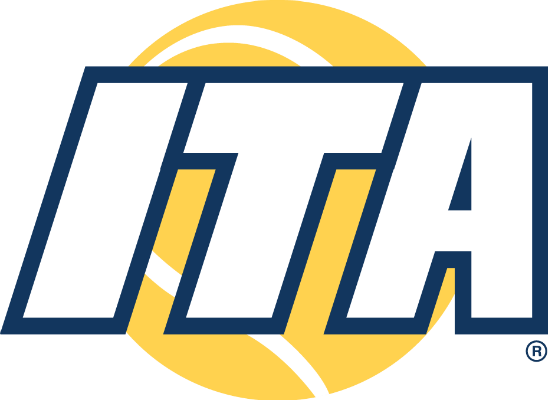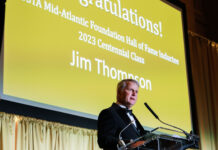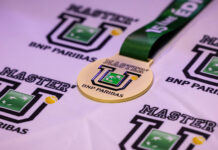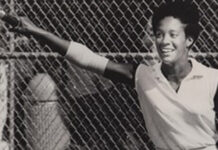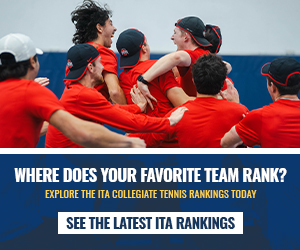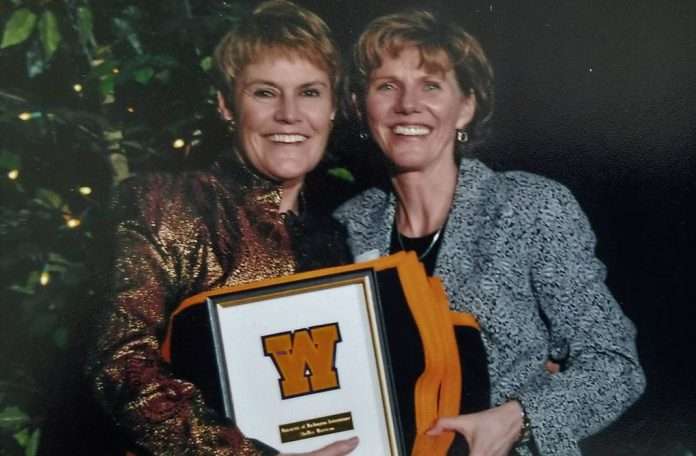
By Shelley Morrison
University of Washington, Class of 1971
At the age of 10, I used to hit against a brick wall between the portables at our local elementary school. The wall and the surrounding buildings formed an imaginary stadium and I would dream I was at Wimbledon. (More about that dream later.)
I had the privilege of playing varsity tennis for four years (1968-1971) at the University of Washington in my hometown of Seattle. UW was part of the Pac-8 at that time. This was also Pre-Title IX. My first two years, we had coaches that weren’t tennis players. When it rained, we practiced inside on the basketball court. The only piece of equipment or team uniform we were given was a UW racket cover. (No one had more than one racket.) Most of the team was from Seattle and the state of Washington. There was no financial support for players and minimal budget for the program. It was quite a contrast to what you find today.
Now, the University of Washington tennis program offers a fabulous indoor tennis center, pristine fast-dry outdoor courts, players recruited from around the world, top-notch coaches and trainers, full scholarships, matching purple uniforms and equipment bags, healthy travel budgets, marketing/promotion, and even an announcer for their matches.
On the Husky team, I had the great fortune of teaming up with Pat (Trish) Bostrom. We started playing doubles together at the age of 13 and competed throughout our junior years on the Pacific Northwest Circuit. Trish was a top-notch player and was competitive with the players from California, who could play year-round. In the northwest, tennis was just a summer sport. I ski raced all winter and played tennis all summer. In our era, there weren’t any indoor courts. At tournaments, we became very skillful at playing cards and ping pong because we were always waiting for courts to dry.
In 1970, when Trish and I were partners on the UW team, the budgets for all women’s varsity sports were cut. We were outraged, and when the Athletic Department did nothing to help, Trish and I went to the Dean of Students and made a clear case that this was not fair. The Dean explained that cuts needed to be made, and “women’s tennis doesn’t bring in any money”. The counter argument was so simple, it was embarrassing. “Well, the men’s tennis, golf, crew, swimming, and gymnastic teams don’t bring in any money, and their budgets weren’t cut.” The Dean decided to reinstate the budget, but only for the women’s tennis team. That didn’t seem fair. So, we shared it with other women’s teams because the UW had some stand-out women swimmers and gymnasts at the time.
The funding situation meant we only had enough money for airfare to get to the Pac-8 Championships at UCLA that year. So, we all stayed at my cousin’s house in Santa Monica. Most of us slept on the floor. We still laugh about that 49 years later. Also that year, Trish and I qualified for the NCAA Nationals in Las Cruces, New Mexico. I know this seems inconceivable now, but we had to pay our own way.
This is a bit of a detour, but important. I am writing this article after the US Women’s National Soccer team won the World Cup. The US Women’s Soccer Team has been the most successful in the sport, winning four Women’s World Cup titles and four Olympic Women’s gold medals. Since their win in France and the ticker-tape parade in Manhattan, so much has been written about Megan Rapinoe and this team, but I want to highlight an article by Liz Clarke published in the Washington Post prior to the World Cup. It provides a good perspective of the gutsy decision of the women’s team to file a class action, gender discrimination lawsuit against the US Soccer Federation before the World Cup. The piece is titled “Double Earners,” a phrase coined by Rapinoe of the Seattle Reign FC, explaining what we all know: Women athletes first have to earn their right to compete, and then they have to earn the respect and financial reward for that work. Billy Jean King and Venus Williams are cited in the article as the models and inspiration for the US Women’s Soccer Team to proceed with their legal challenge, despite added pressure.
“Billie Jean King was the pioneer ….threatened with being banned from Grand Slam events and stripped of her ranking by the all-male tennis establishment for launching a women’s circuit in the early 1970s, in concert with eight other female touring pros, to ensure they had a place to compete.
There is a direct line from King’s advocacy to that of Venus Williams, who took up the mantle of equal pay and convinced Wimbledon, the most prestigious of the sport’s four majors, to pay its male and female champions the same in 2007. There is a direct line, in turn, to the women’s soccer team’s decades-long fight for better pay and working conditions” (Washington Post).
I was in Paris last month. My 28-year-old son, Charlie, took me to the French Open to celebrate my 70th birthday, which is in November, but who cares. We saw amazing tennis and the women had as many “big names” as the men. I was struck by Charlie’s comment, while we were watching a match. “Isn’t it incredible, mom, that professional tennis is the only sport where the prize money is the same for men and women?” Yes, it is.

June 2019 photo of Trish and me at a reunion of the PNW Circuit.
Trish Bostrom was a pioneer in that struggle. She won a Pac-8 title and sued the university for the right to play on the UW men’s team because the women’s program was inadequate. She won the suit. She went on to play professional tennis (and become a successful lawyer).
A recent article in the Seattle Times noted, “Patricia Bostrom is considered the greatest women’s tennis player in University of Washington history, but it’s her role as a pioneer for gender equality in college sports that she is most proud of and for which she is often remembered.”
Trish and I used to come back to campus and meet the then current Husky women’s tennis team. We would start our pep talk with how “We both got to Wimbledon.” Of course, everyone knew who Trish was, but the players would look at me and think, “Who in the hell are you?” But, it’s true…in the late 70’s, there were two Huskies at the Wimbledon Championships…Trish was on the court with a racket in her hand, and I was in the press box with a microphone in mine.
I started my career in radio as “The Horoscope Lady” at WHWB Radio in Rutland, Vermont. My big break came in 1974. I was hired by NBC to be the first female sportscaster on Network radio as a co-host of “Sports Update”. Tennis was my ticket. When Billy Jean King played Bobby Riggs, there were no experienced women sportscasters to balance the broadcast team. Sports Illustrated wrote an article afterward stating it was time to have female sports broadcasters. It was tennis that led the way. Billy Jean and the pioneers of the Virginia Slims circuit created a demand for coverage of women’s tennis.
The only other woman in sports broadcasting for a network, at this time, was the former Miss America, Phillis George, who started doing sideline commentary for NFL games on CBS. There’s that old joke, “I have a face for radio.” In my case, I had the voice for radio, a very deep tenor. One male colleague at NBC described it as “a ballsy voice,” which meant, if she sounds like a man maybe we can get away with this.
I was based in New York, 30 Rock to be specific, and I covered the regular sports beat. I was also hired to be the stadium announcer for the New York Sets in the very first season of World Team Tennis. Trish played for the Boston Lobsters, so we got to see each other when our teams matched up. Later, I was the play-by-play announcer for the Sea-Port Cascades. Trish was then with the Indiana Loves, and again we got to connect.
I experienced some of the skepticism you would expect as a token woman in the field, but also camaraderie and support. NBC was wonderful to me, and my producer, Herb Gordon, became a life-long friend. For my World Team Tennis role, I was mentored by “The Zink”. David Zinkoff was the famous stadium announcer for the Philadelphia 76rs. A male colleague from the Daily News took me to cover my first boxing match and I took him to cover his first tennis match. At Madison Square Garden, when I went to join the other reporters in the Press Club, and I was not allowed to enter. It was male only. But, John Condon, the “Voice of the Knicks” and then President of Madison Square Garden Boxing, immediately stepped in and welcomed me. He didn’t say anything about my gender, just… “We are certainly not going to exclude NBC.” Smart man. I was a novelty and my agent got me gigs like announcer for the World Frisbee Championships at the Rose Bowl and the Sports Illustrated Freestyle Skiing tour.
In 1977, NBC asked me to move to London to be part of the team preparing for the Moscow Olympics. That was the year I was assigned to my first Wimbledon. I had the incredible privilege of covering the Borg-McEnroe and Evert-Navratilova years. I also got to see Trish, which was a thrill. I covered Wimbledon for the next seven years, until 1983. The United States pulled out of the Moscow Olympics, but I later got my chance with ABC Sports to cover the 1984 Olympics in Sarajevo and Los Angeles and the ’88 Winter Games in Calgary.
In 1984, I pivoted from broadcasting to marketing, sales and public relations. For six years, I worked for the Seattle SuperSonics with the NBA, as Director of Advertising and Director of Marketing. In 1995, I was hired by Starwave and was part of the team that launched ESPN.com, one of first websites on the commercial internet. After that, we published Outside Online, NBA.com, NFL.com and NASCAR Online. Later, I joined RealNetworks, which created the capability to stream sports live on the internet.

About a decade ago, the University of Washington, decided to celebrate all the women athletes, who competed prior to Title IX. We were presented with our varsity letters and blankets with the big gold “W”. This means at UW homecoming we get to go out of the field during a Husky football game with all the other men and women who had the privilege and honor of playing varsity sports at the school.
Playing varsity tennis at the UW had many benefits for me professionally, some I have already mentioned and are obvious. When I got into the work world, I realized that one of the advantages most men had was having played organized team sports. They had a language, a common experience of being coached, playing a position, practicing plays, discussing strategy, winning or losing together, bonding and supporting each other. Most of my professional women colleagues did not have this experience or background. For me, just being able to “talk sports” was an advantage. When male executives wax on about having played sports in college, I can mention that I did, too. The follow-up question is always. “Did you play varsity?” My proud answer is always “YES!” (and, I have the “W” to prove it.)
I have written this piece in gratitude. I am grateful for the opportunity to have been a Husky. I’m grateful to my dad (also a Husky), who taught me how to play tennis and never let me think for a minute there was something I couldn’t do because I was girl. I’m grateful for my partnership with Trish Bostrom. I’m grateful for my exciting and fulfilling career, and the role competitive tennis played in it.
Tennis has been a gift, and it is the gift that keeps on giving. At my age, that means bad knees, pulled tendons, sun-challenged skin and large supplies of KT tape and CBD cream. But, who’s complaining? I play on three USTA teams, 40+, 55+ and 65+. It is a joy. And luckily, when my 65+ team goes to the Sectionals, we don’t have to sleep on the floor.
-Shelley Morrison, University of Washington Tennis, 1971

